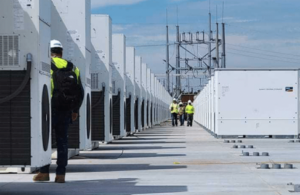powering up intellectual property protection in renewable energy


Powin’s 50 MW/66.2 MWh battery storage project in Texas. (Courtesy: Powin)
Contributed by Matthew R. Carey, partner and registered patent lawyer, Marshall, Gerstein & Borun, LLP
Artificial intelligence (AI) is poised to revolutionize the renewable energy landscape, helping usher in a new era of sustainability and efficiency. As the world grapples with the need to transition toward clean energy sources, AI will emerge as a powerful ally. From forecasting renewable production and demand to optimizing project design, AI algorithms are already driving transformative changes that will accelerate the adoption of renewable energy, reduce carbon emissions, and pave the way for a greener future.
AI is already seeing increased utilization across various renewable energy sectors. For example, AI algorithms are being deployed in the management of solar and wind farms to predict energy output more accurately and optimize the operation of these renewable energy systems in real-time. Further, AI is instrumental in integrating renewable energy into the power grid by employing advanced forecasting models to anticipate fluctuations in renewable energy supply and demand, enabling grid operators to balance the grid more effectively, especially as the proportion of renewable energy sources increases.
Looking ahead, the potential applications of AI in optimizing renewable energy sources are boundless.
One promising avenue is the development of AI-powered energy storage systems, which may dynamically analyze consumption patterns and grid dynamics to optimize the charging and discharging of energy storage devices such as batteries, maximizing their efficiency and lifespan. Additionally, AI can revolutionize the design of renewable energy infrastructure. By leveraging machine learning algorithms and generative design techniques, engineers can develop innovative solutions that maximize energy capture while minimizing environmental impact. From wind turbine blade design to solar panel orientation, AI-driven optimization algorithms can unlock new levels of efficiency and cost-effectiveness in future renewable energy systems.
Companies operating in the renewable energy sector face a multitude of reasons why protecting their intellectual property (IP) is paramount.
First, given the rapid pace of technological advancements in a highly competitive market, IP protection serves as a crucial tool for differentiation, enabling organizations to carve out niches for themselves by offering unique and inventive solutions. Additionally, the long and resource-intensive development cycles characteristic of renewable energy technologies necessitate IP protection to give companies a stronger likelihood of recouping their investments over time. As these companies expand to additional jurisdictions, navigating diverse regulatory environments and market conditions becomes easier with IP protection, which safeguards innovations from unauthorized use or replication.
Furthermore, fostering partnerships and collaborations is common practice in the renewable energy sector, and IP protection facilitates these endeavors by providing a framework for sharing proprietary information while ensuring that each party’s interests are preserved. Ultimately, beyond purely business concerns, protecting IP in the renewable energy sector holds significant implications for environmental sustainability, as it incentivizes innovation and investment in cleaner and more sustainable energy solutions, thereby benefitting society as a whole.
However, safeguarding IP presents companies with unique considerations and challenges, given the intricate nature of the technologies involved and the competitive global market. Companies often have multifaceted innovations involving sophisticated processes or systems, thereby posing a complexity in identifying and comprehensively securing all elements of their IP.
Moreover, operating on an international scale exposes organizations to diverse legal frameworks and cultural norms, necessitating a nuanced approach to protecting their assets. Collaborative ventures are common in this sector, raising concerns about IP protection amidst knowledge-sharing endeavors. Regulatory uncertainties and rapid policy changes add another layer of complexity, heightening the need for vigilance in IP protection strategies.
Companies can adopt strategic measures to tackle these challenges effectively. A comprehensive IP strategy tailored to the intricacies of renewable energy technologies is of prime importance, especially as it applies to patents and trade secrets. An international filing strategy ensures protection in key markets worldwide, often through mechanisms like the Patent Cooperation Treaty (PCT). Clear IP ownership and licensing terms should be negotiated in collaborative agreements to balance innovation and protection. Conducting thorough freedom-to-operate (FTO) analyses helps navigate patent landscapes and mitigate infringement risks. Robust monitoring and enforcement mechanisms enable proactive detection and response to potential infringements, effectively safeguarding the company’s interests.
By proactively addressing these considerations and challenges, companies in the renewable energy sector can fortify their IP assets, maintain competitiveness, and drive innovation in this exciting global marketplace.
DISCLAIMER: The information contained in this article is for informational purposes only and is not legal advice or a substitute for obtaining legal advice from an attorney. Views expressed are those of the author and are not to be attributed to Marshall, Gerstein & Borun LLP or any of its former, present, or future clients.
About the author

Matthew R. Carey is a partner and registered patent lawyer with Marshall, Gerstein & Borun, LLP, and a contributing author to the PatentNext law blog focusing on next-generation and new-age technologies. He may be reached at mcarey@marshallip.com




Your point of view caught my eye and was very interesting. Thanks. I have a question for you.